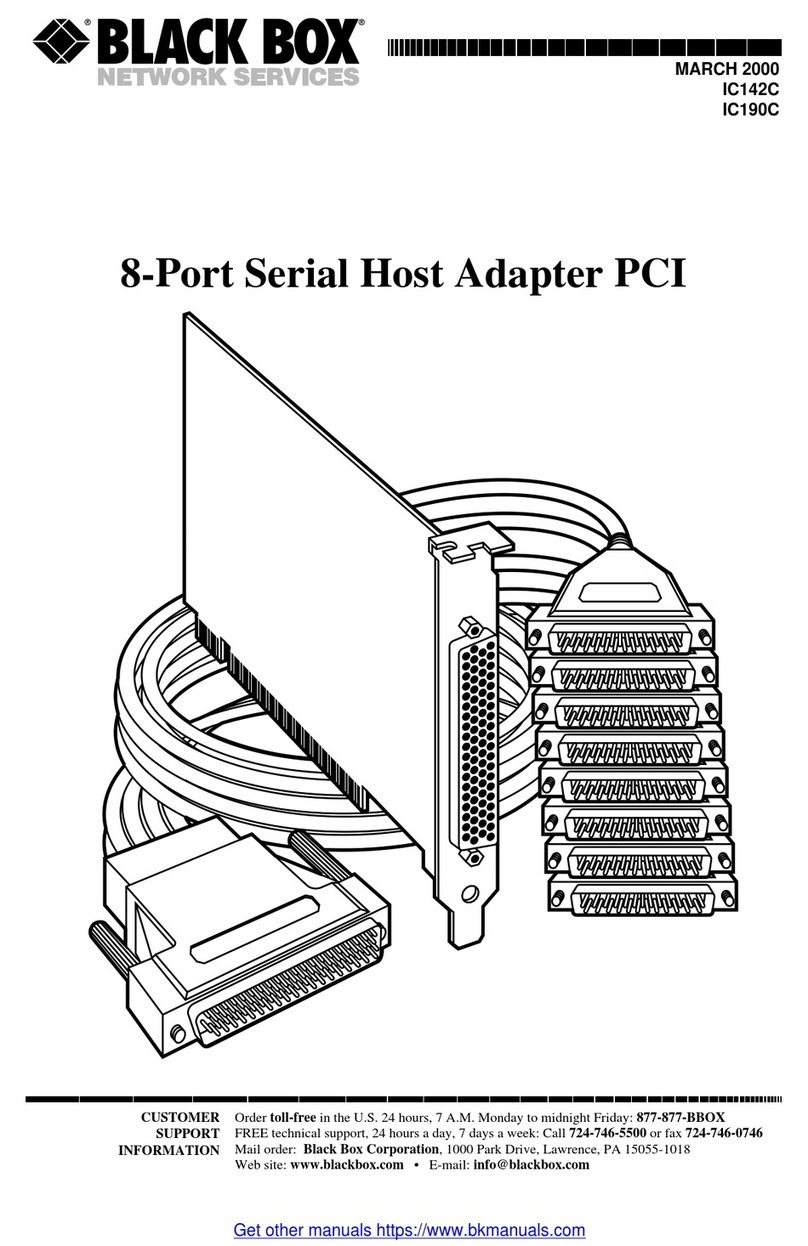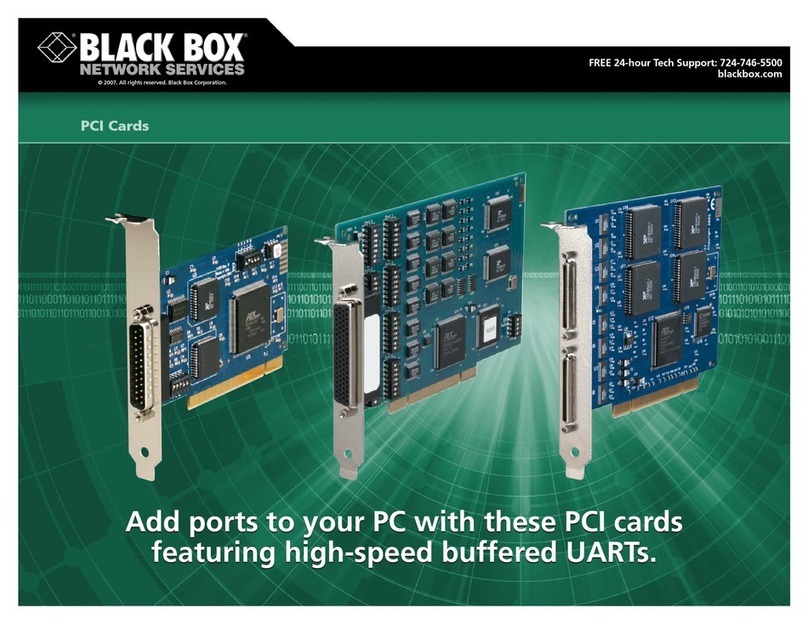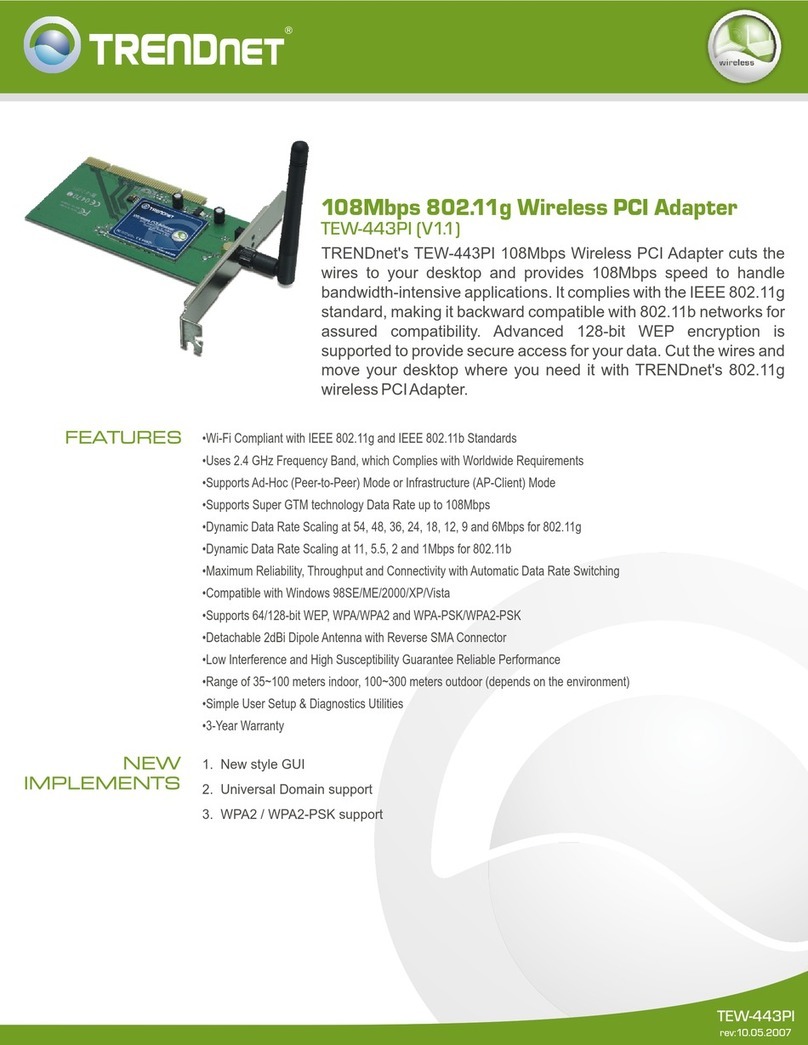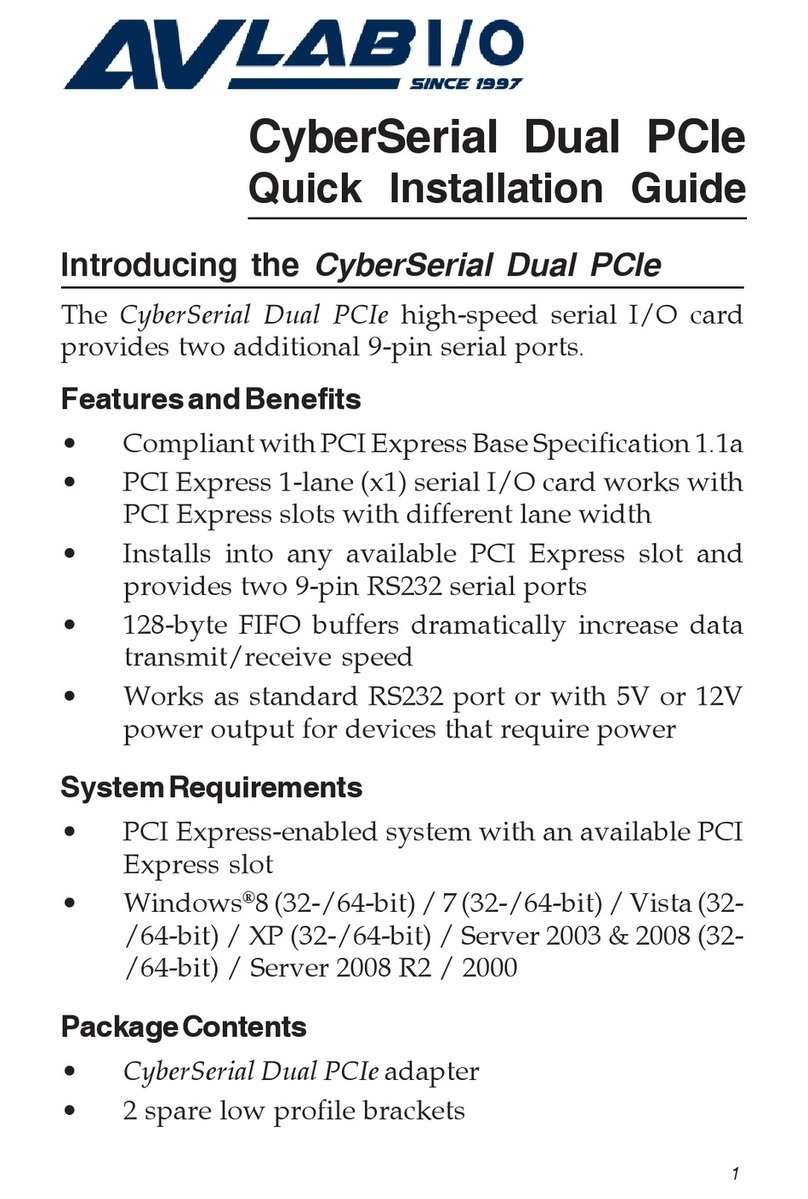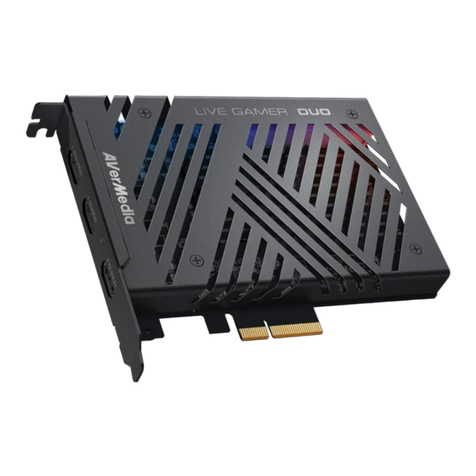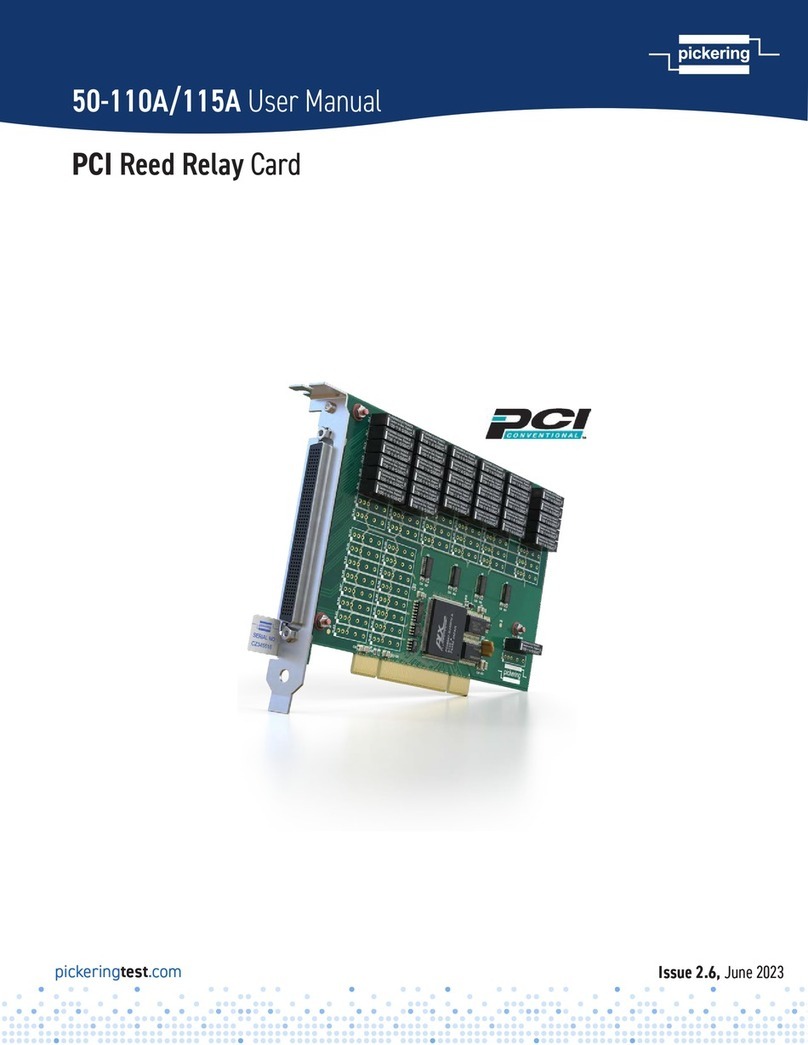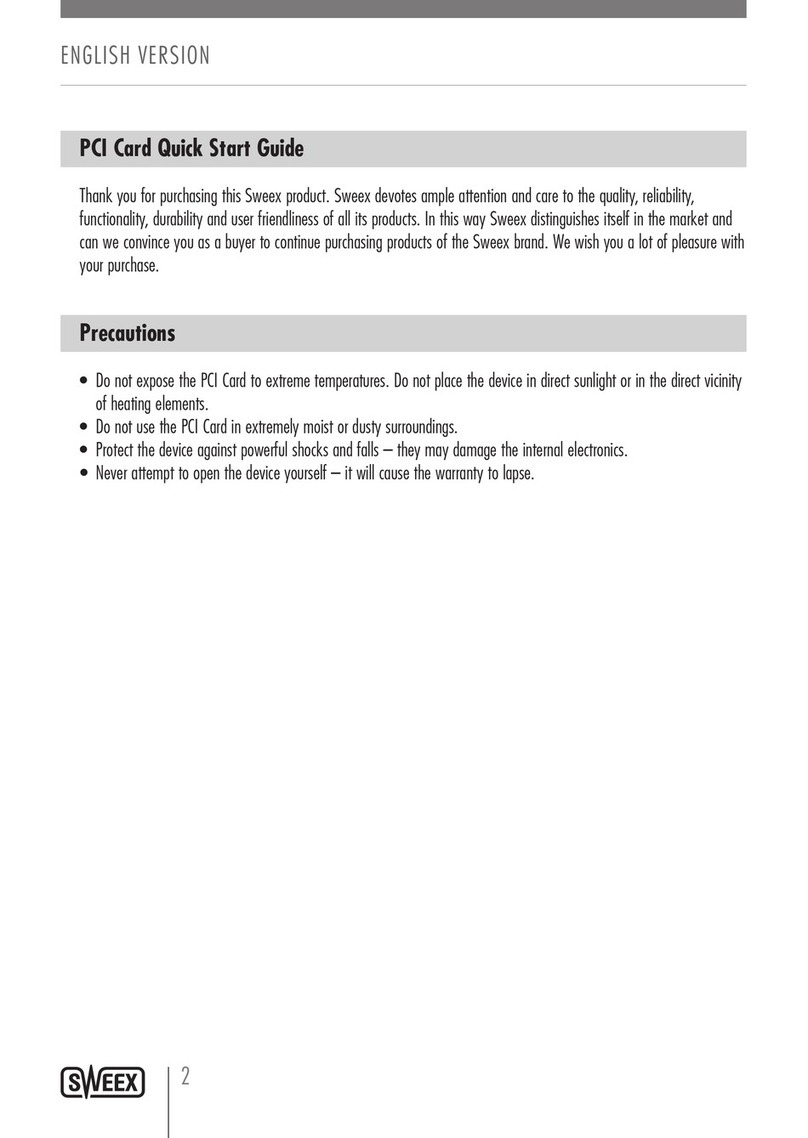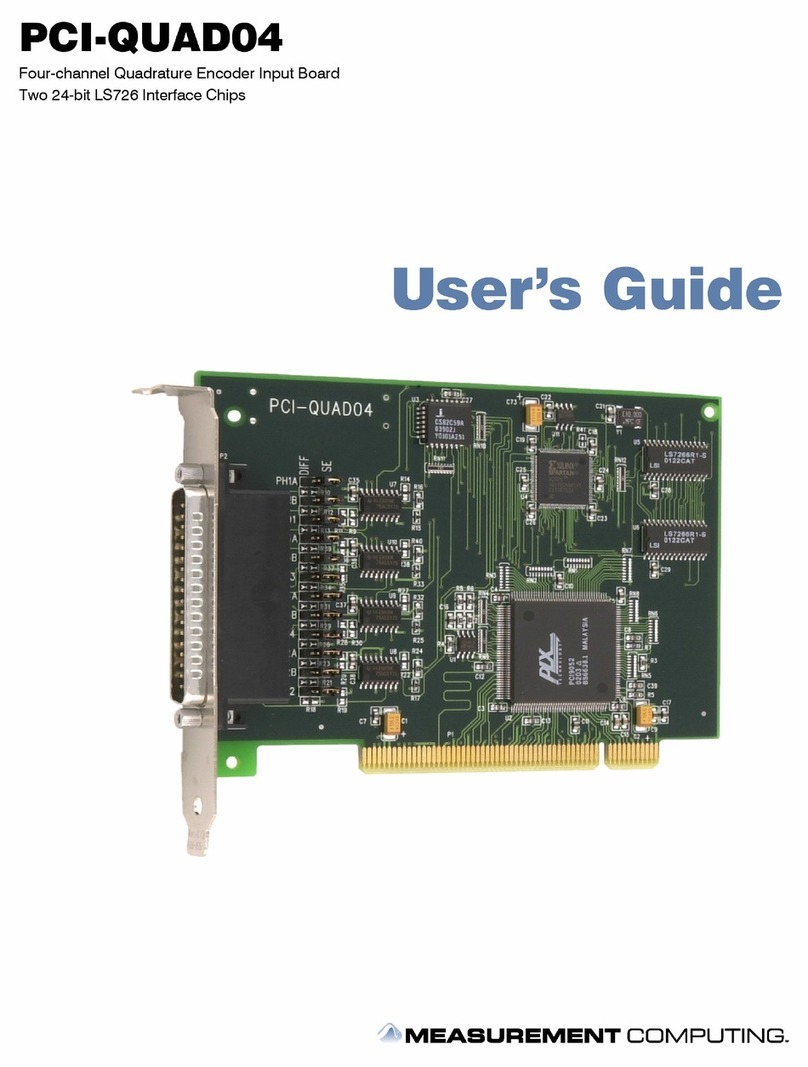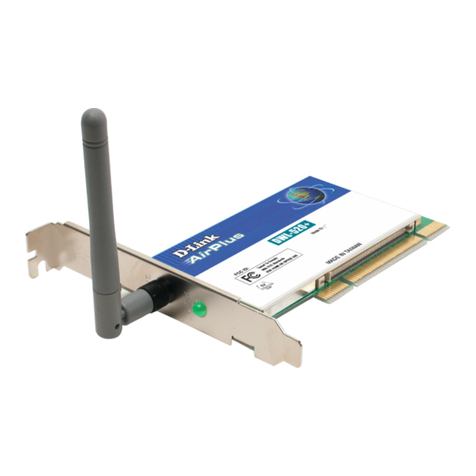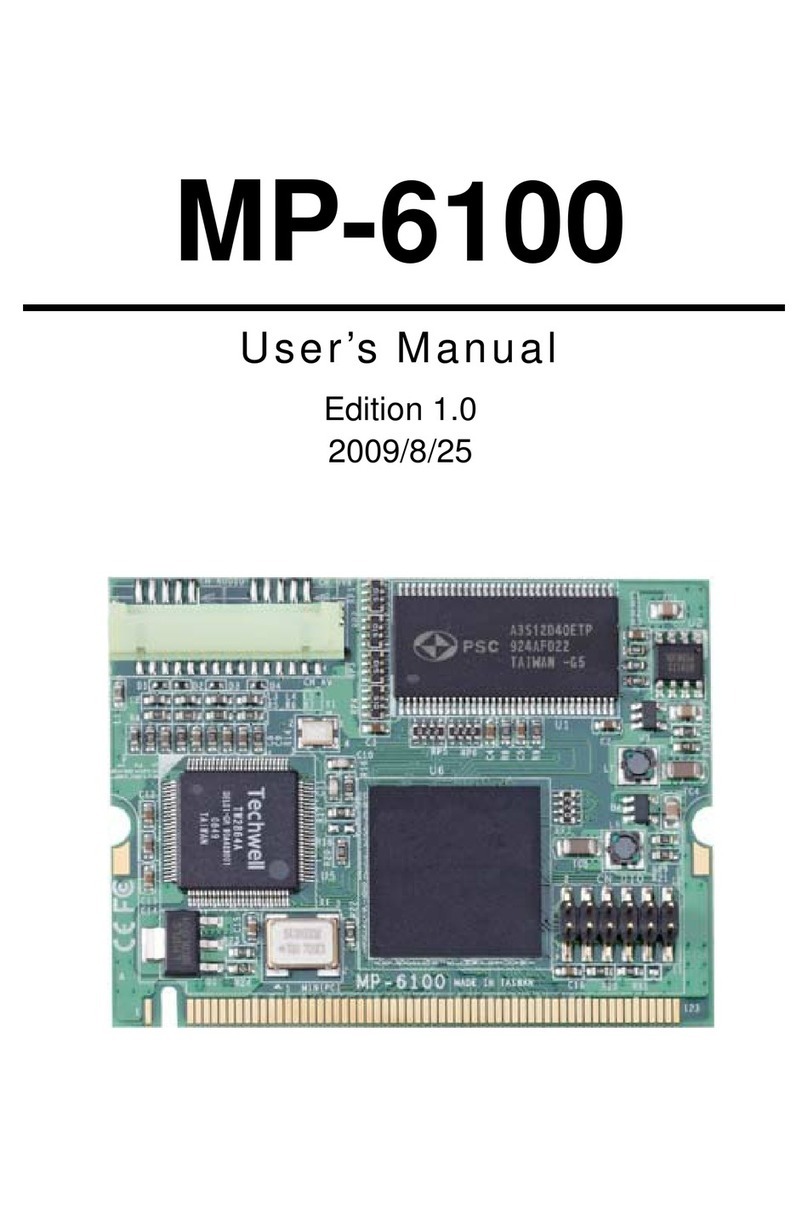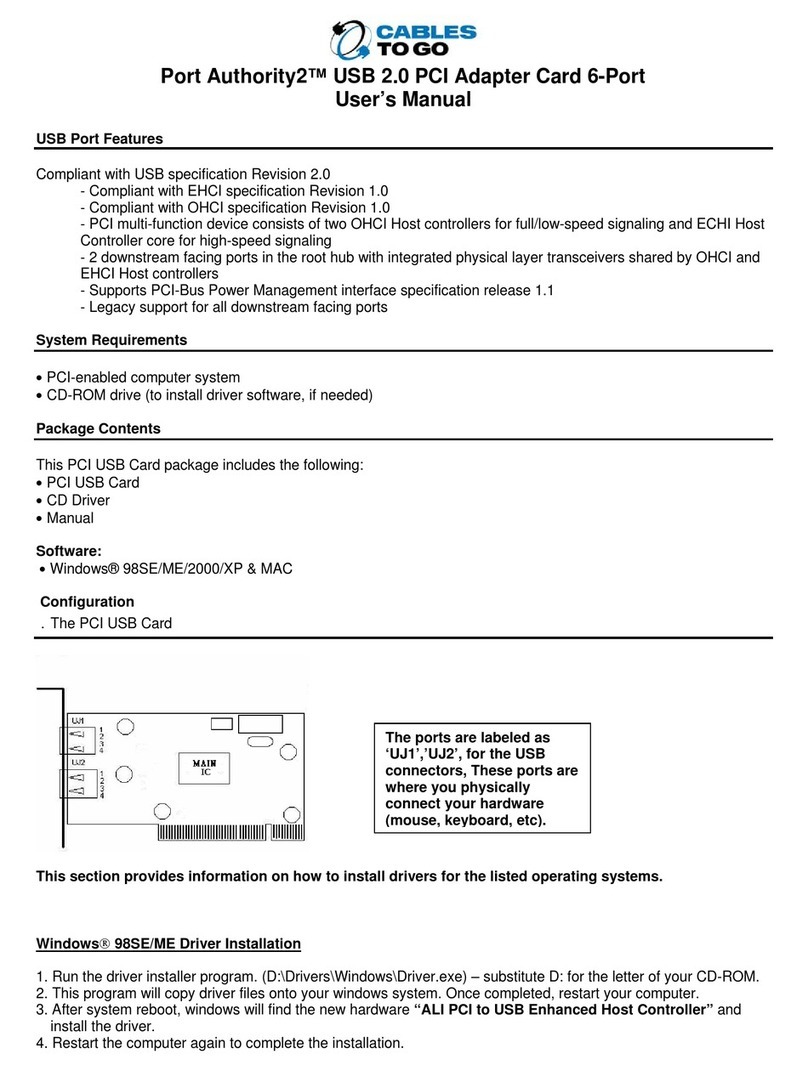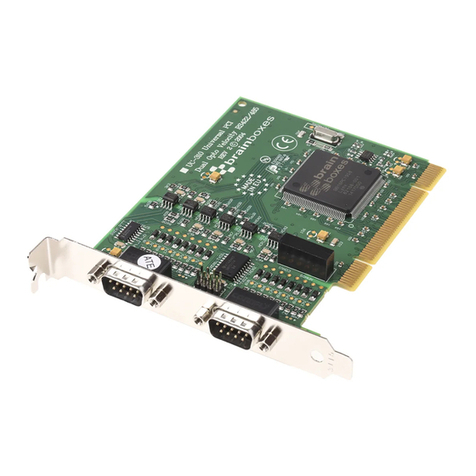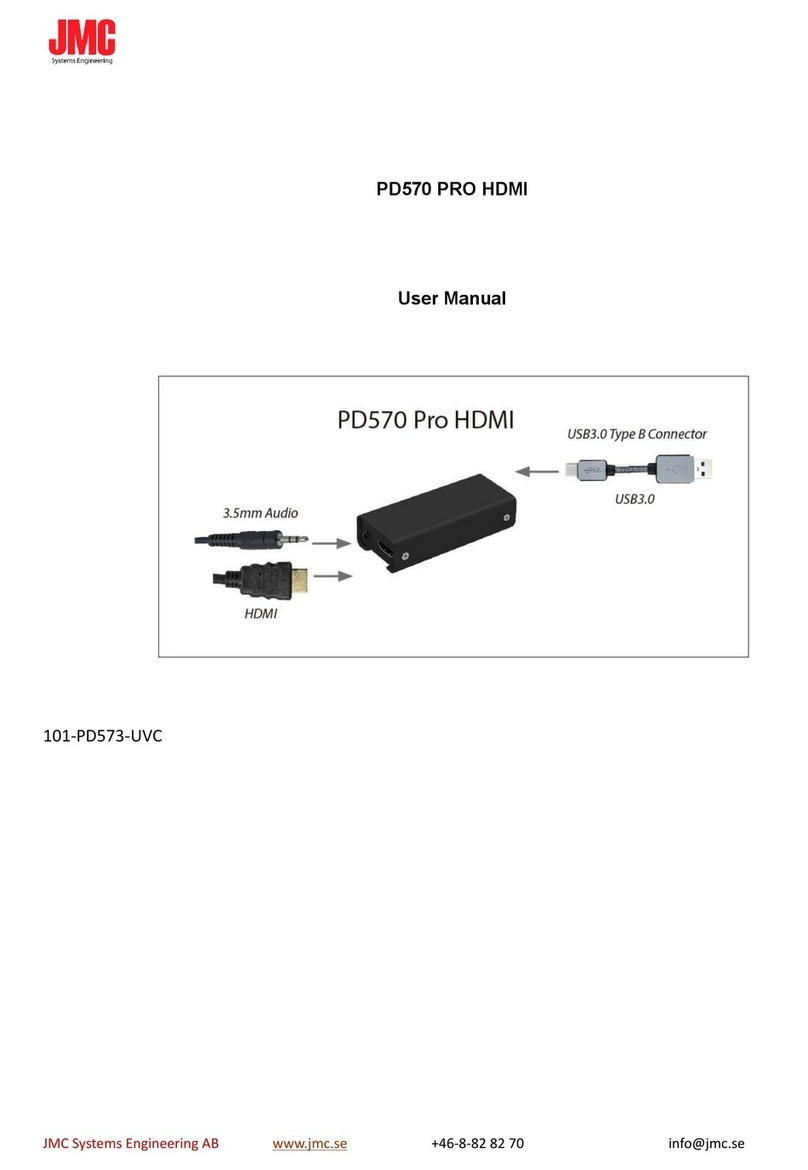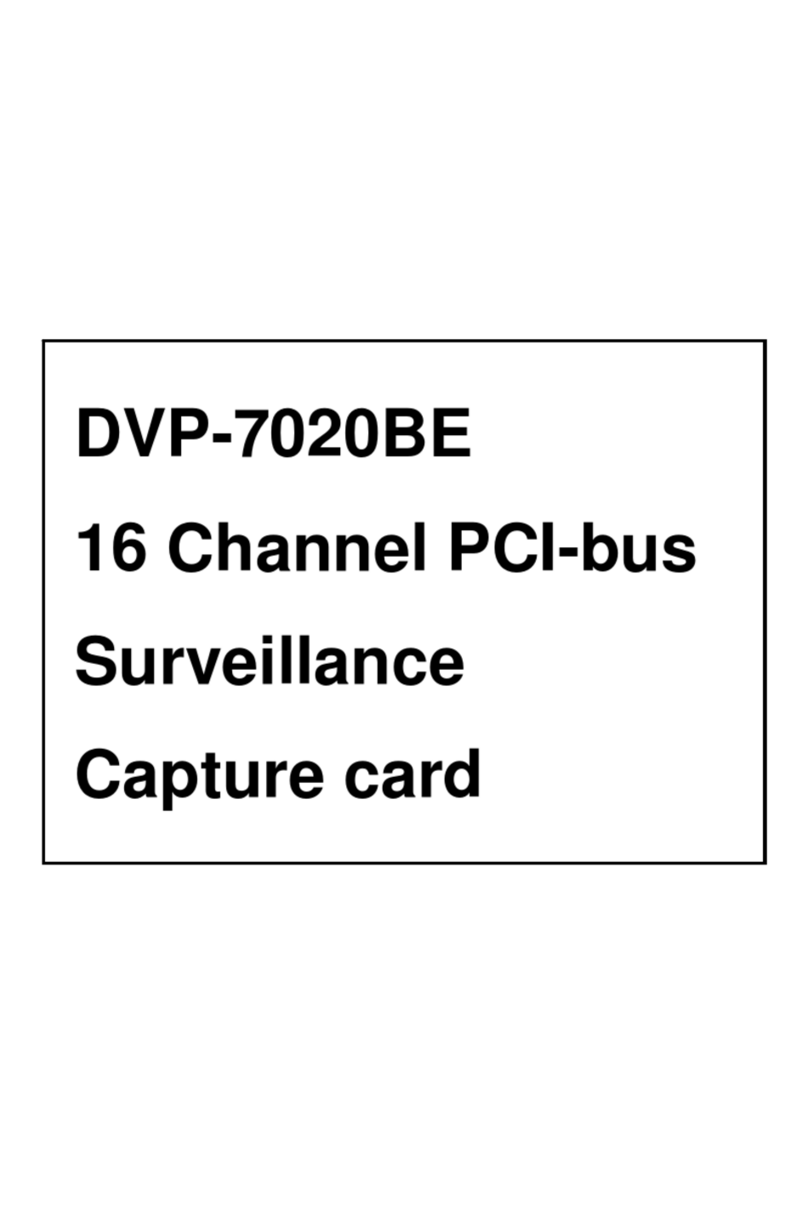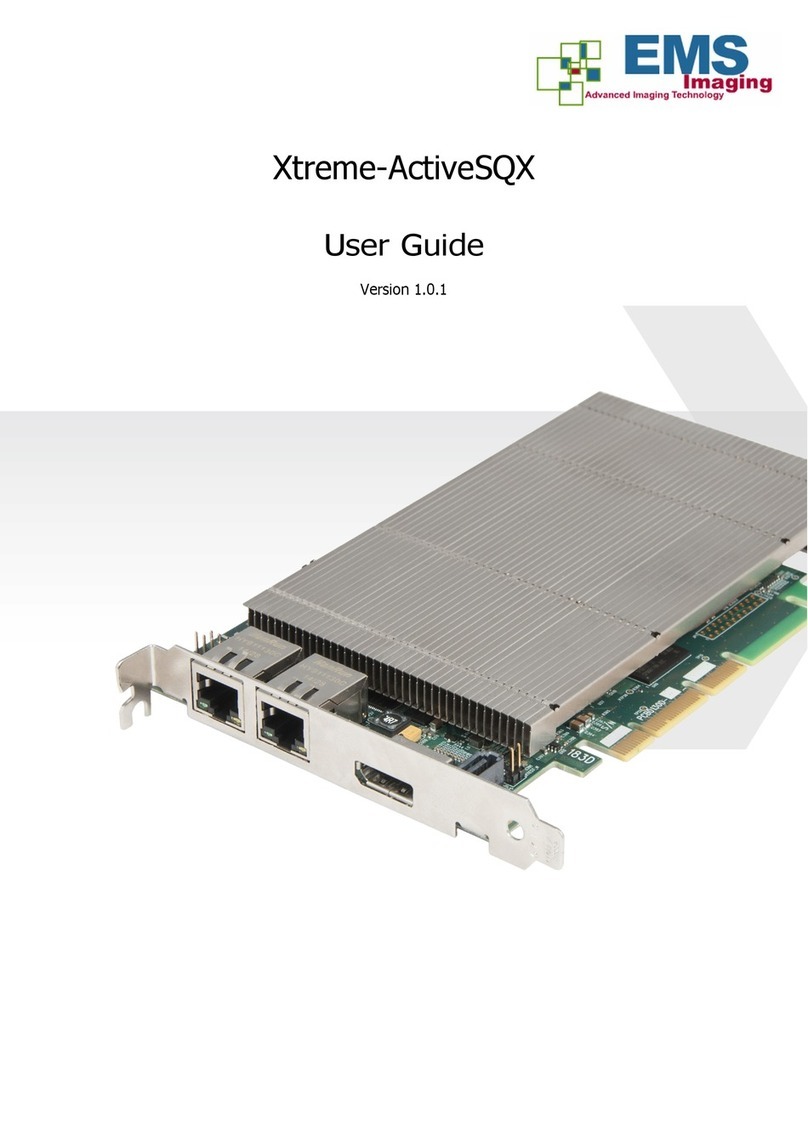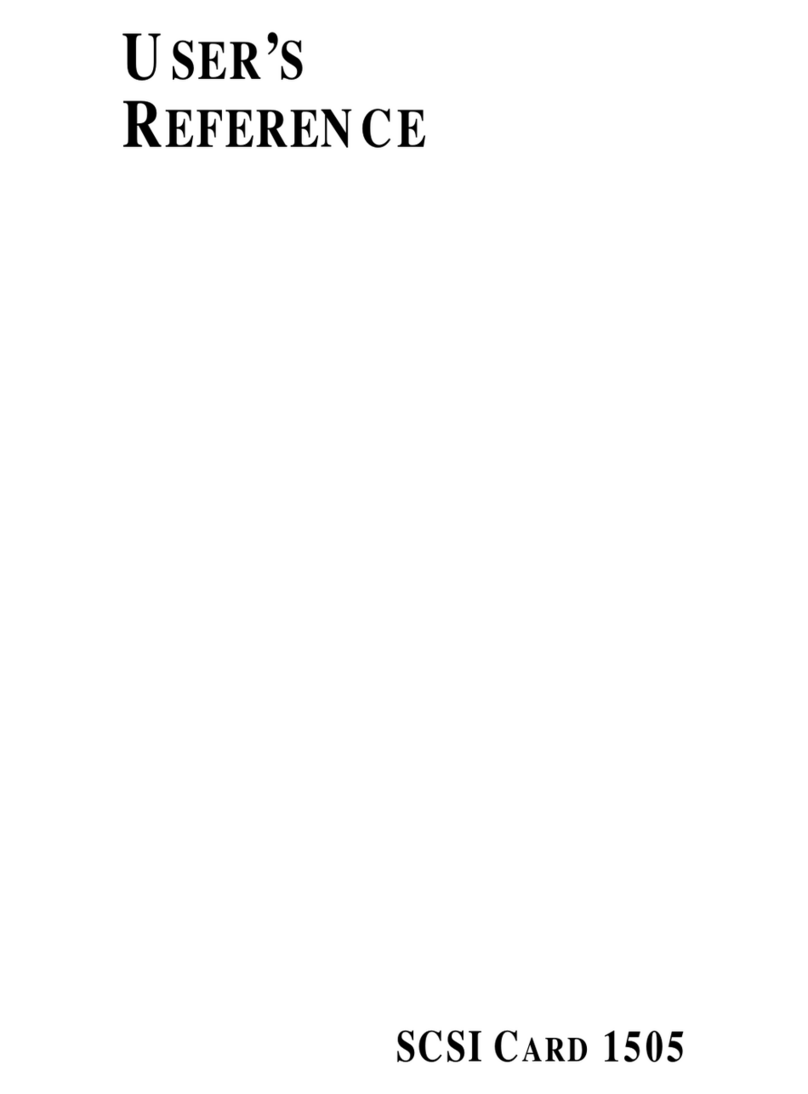Black Box USB Director RS-232 User manual

CUSTOMER
SUPPORT
INFORMATION
Order toll-free in the U.S. 24 hours, 7 A.M. Monday to midnight Friday: 877-877-BBOX
FREE technical support, 24 hours a day, 7 days a week: Call 724-746-5500 or fax 724-746-0746
Mail order: Black Box Corporation, 1000 Park Drive, Lawrence, PA 15055-1018
NOVEMBER 2001
IC073C
IC074C-R2
Single-Port PCI Card—
RS-232/422/485/530

1
TRADEMARKS
TRADEMARKS USED IN THIS MANUAL
OS/2 and PS/2 are registered trademarks of International Business Machines
Corporation.
Windows and Windows NT are registered trademarks of Microsoft Corporation.
UL is a registered trademark of Underwriters Laboratories Incorporated.
Any other trademarks used in this manual are acknowledged to be the property of the
trademark owners.

2
SINGLE-PORT PCI CARD—RS-232/422/485/530
FEDERAL COMMUNICATIONS COMMISSION
AND
INDUSTRY CANADA
RADIO FREQUENCY INTERFERENCE STATEMENTS
This equipment generates, uses, and can radiate radio frequency energy and if not
installed and used properly, that is, in strict accordance with the manufacturer’s
instructions, may cause interference to radio communication. It has been tested
and found to comply with the limits for a Class A computing device in accordance
with the specifications in Subpart B of Part 15 of FCC rules, which are designed to
provide reasonable protection against such interference when the equipment is
operated in a commercial environment. Operation of this equipment in a
residential area is likely to cause interference, in which case the user at his own
expense will be required to take whatever measures may be necessary to correct
the interference.
Changes or modifications not expressly approved by the party responsible for
compliance could void the user’s authority to operate the equipment.
This digital apparatus does not exceed the Class A limits for radio noise emission from digital
apparatus set out in the Radio Interference Regulation of Industry Canada.
Le présent appareil numérique n’émet pas de bruits radioélectriques dépassant les limites
applicables aux appareils numériques de la classe A prescrites dans le Règlement sur le
brouillage radioélectrique publié par Industrie Canada.

3
NOM STATEMENT
NORMAS OFICIALES MEXICANAS (NOM)
ELECTRICAL SAFETY STATEMENT
INSTRUCCIONES DE SEGURIDAD
1. Todas las instrucciones de seguridad y operación deberán ser leídas antes de
que el aparato eléctrico sea operado.
2. Las instrucciones de seguridad y operación deberán ser guardadas para
referencia futura.
3. Todas las advertencias en el aparato eléctrico y en sus instrucciones de
operación deben ser respetadas.
4. Todas las instrucciones de operación y uso deben ser seguidas.
5. El aparato eléctrico no deberá ser usado cerca del agua—por ejemplo, cerca
de la tina de baño, lavabo, sótano mojado o cerca de una alberca, etc..
6. El aparato eléctrico debe ser usado únicamente con carritos o pedestales que
sean recomendados por el fabricante.
7. El aparato eléctrico debe ser montado a la pared o al techo sólo como sea
recomendado por el fabricante.
8. Servicio—El usuario no debe intentar dar servicio al equipo eléctrico más allá
a lo descrito en las instrucciones de operación. Todo otro servicio deberá ser
referido a personal de servicio calificado.
9. El aparato eléctrico debe ser situado de tal manera que su posición no
interfiera su uso. La colocación del aparato eléctrico sobre una cama, sofá,
alfombra o superficie similar puede bloquea la ventilación, no se debe colocar
en libreros o gabinetes que impidan el flujo de aire por los orificios de
ventilación.
10. El equipo eléctrico deber ser situado fuera del alcance de fuentes de calor
como radiadores, registros de calor, estufas u otros aparatos (incluyendo
amplificadores) que producen calor.
11. El aparato eléctrico deberá ser connectado a una fuente de poder sólo del
tipo descrito en el instructivo de operación, o como se indique en el aparato.

4
SINGLE-PORT PCI CARD—RS-232/422/485/530
12. Precaución debe ser tomada de tal manera que la tierra fisica y la polarización
del equipo no sea eliminada.
13. Los cables de la fuente de poder deben ser guiados de tal manera que no
sean pisados ni pellizcados por objetos colocados sobre o contra ellos,
poniendo particular atención a los contactos y receptáculos donde salen del
aparato.
14. El equipo eléctrico debe ser limpiado únicamente de acuerdo a las
recomendaciones del fabricante.
15. En caso de existir, una antena externa deberá ser localizada lejos de las lineas
de energia.
16. El cable de corriente deberá ser desconectado del cuando el equipo no sea
usado por un largo periodo de tiempo.
17. Cuidado debe ser tomado de tal manera que objectos liquidos no sean
derramados sobre la cubierta u orificios de ventilación.
18. Servicio por personal calificado deberá ser provisto cuando:
A: El cable de poder o el contacto ha sido dañado; u
B: Objectos han caído o líquido ha sido derramado dentro del aparato; o
C: El aparato ha sido expuesto a la lluvia; o
D: El aparato parece no operar normalmente o muestra un cambio en su
desempeño; o
E: El aparato ha sido tirado o su cubierta ha sido dañada.

5
CE COMPLIANCE
CE Compliance
Products bearing the CE label fulfill the requirements of the EMC directive
(89/336/EEC) and of the low-voltage directive (73/23/EEC) issued by the
European Commission.
To obey these directives, the following European standards must be met:
•EN55022 Class A — “Limits and methods of measurement of radio
interference characteristics of information technology equipment.”
•EN50082-1 — “Electromagnetic compatibility — Generic immunity standard.”
Part 1: Residential, commercial, and light industry.
•EN60950 (IEC950) — “Safety of information technology equipment, including
electrical business equipment.”
WARNING
This is a Class A Product. In a domestic environment this product may
cause radio interference in which case you may be required to take
adequate measures.
Always use cabling provided with this product if possible. If no cable is provided or
if an alternate cable is required, use high-quality shielded cabling to maintain
compliance with FCC/EMC directives.

6
SINGLE-PORT PCI CARD—RS-232/422/485/530
Contents
Chapter Page
1. Specifications ..........................................................................................................7
2. Introduction............................................................................................................8
2.1 Overview ............................................................................................................8
2.2 What’s Included ................................................................................................8
2.3 Technical Description ......................................................................................9
2.3.1 Isochronous Communications................................................................9
2.3.2 Connector Pin Assignments ..................................................................10
3. Card Setup ............................................................................................................12
3.1 RS-485 Enable Modes ....................................................................................12
3.2 Address and IRQ Selection ............................................................................14
3.3 Line Termination............................................................................................15
3.4 Electrical Interface Selection ........................................................................16
3.5 Clock Modes....................................................................................................17
3.6 Baud Rates and Divisors for the “Div1” Mode ..............................................18
3.7 Isochronous Clocking Jumpers......................................................................19
4. Installation ............................................................................................................22
4.1 Operating System Installation........................................................................22
4.2 System Installation ..........................................................................................22
Appendix A. Troubleshooting ..................................................................................23
A.1 Using Serial Utility Software ..........................................................................23
A.2 PCI COM Number Selection in Windows 95/98 ........................................24
A.3 Calling Black Box............................................................................................24
A.4 Shipping and Packaging ................................................................................25
Appendix B. Electrical Interface ..............................................................................26
B.1 RS-232 ..............................................................................................................26
B.2 RS-422 ..............................................................................................................26
B.3 RS-485 ..............................................................................................................27
B.4 RS-530 ..............................................................................................................27
Appendix C. Asynchronous Communication ..........................................................28
Appendix D. Block Diagram......................................................................................30

7
CHAPTER 1: Specifications
1. Specifications
Communications Chip — IC073C: 16550; IC074C-R2: 16850
Number of Ports — Single RS-232/422/485/530
Maximum Data Rate — 460.8 kbps
Maximum Data Distance — 5000 feet (1524 m), RS-422
Connectors — (1) DB25 male
Temperature Range — Operating: 32 to 122°F (0 to 50°C);
Storage: -4 to +158°F (-20 to +70°C)
Humidity Range — 10 to 90%, noncondensing
MTBF — >150,000 hours
Board Construction — Built to UL®94V0 rating; 100% electrically tested; Boards
are solder mask over bare copper or solder mask over tinned nickel
Power Consumption — +5V @ 130 mA, +12V @ 30 mA, -12V @ 40 mA
Size — 3.5"H x 4.9"L (8.9 x 12.4 cm)
Weight — <1 lb. (<0.5 kg)

8
SINGLE-PORT PCI CARD—RS-232/422/485/530
2. Introduction
2.1 Overview
The Single-Port PCI Card—RS-232/422/485/530 is a one-channel PCI Bus
serial I/O adapter for PCs. It provides one field-selectable RS-232/422/485/530
serial port supporting asynchronous data rates up to 460.8 kbps as well as
isochronous data rates up to the speed of the supplied clock. With this card, you
can use your standard communications software and connect over a clocked digital
communications line.
Configure the port as RS-232 for standard serial COM-port requirements. Choose
the RS-422 mode for long-distance device connections up to 4000 feet (1219.2 m)
where noise immunity and high data integrity are essential. Select RS-485 and
capture data from multiple peripherals in a RS-485 multidrop network. Up to 31
RS-485 devices can be connected to each port to automate your data collection.
In both RS-232 and RS-422 modes, the card works seamlessly with the standard
operating system serial driver. In RS-485 mode, our special auto-enable feature
allows the RS-485 ports to be viewed by the operating system as a COM port. This
allows the standard COM driver to be used for RS-485 communications. Our on-
board hardware automatically handles the RS-485 driver enable. The standard
version (IC073C) has a 64-byte FIFO. A UART upgrade is available (IC074C-R2)
providing a 128-byte FIFO.
2.2 What’s Included
The Single-Port PCI Card—RS-232/422/485/530 (IC073C) is shipped with the
following items. If any items are missing or damaged, call us.
• Single-Port PCI Card—RS-232/422/485/530
• Serial Utility Software on two 3.5" disks
• This User’s Manual
The Single-Port PCI Card 16850 UART Upgrade—RS-232/422/485/530
(IC074C-R2) is shipped with the following items. If any items are missing or
damaged, call us.
• The UART 16850 chip mounted on the Single-Port PCI Card
• This User’s Manual

9
CHAPTER 2: Introduction
2.3 Technical Description
The Single-Port PCI Card provides an additional asynchronous serial port that
can be set as RS-232 (for modems, printers, and plotters) or RS-422/485/530
for industrial automation and control applications.
The Single-Port PCI Card uses the 16550 UART. This chip features programmable
baud rates, data format, interrupt control, and 16-byte input and output FIFO.
An optional upgrade (IC074C-R2) gives the Single-Port PCI Card an Oxford
Semiconductor 16850 UART. This chip features a deep FIFO (128 bytes transmit
and receive), automatic RS-485 driver enable, and the ability to receive a clock for
isochronous communications. For a 16850 UART upgrade, call Black Box at 724-
746-5500 and request part number IC074C-R2.
2.3.1 I
SOCHRONOUS
C
OMMUNICATIONS
In synchronous communication, data transmission depends on both ends being
synchronized to a single clock. In asynchronous communication, there is no clock;
instead, each data bit is surrounded by a frame of start, stop, and parity bits. In
isochronous communication, the framing bits of asynchronous communication are
combined with the synchronized clock of synchronous communication. This
scheme allows for much higher data rates and the use of digital lines (such as
ISDN or T1) where a clock is supplied for data multiplexing.
Now, with a simple communications interface that responds to standard
communication calls, high-speed communications can be accomplished. For
example, say Company A wishes to send daily reports from the London office to its
New York office via an established satellite link. These links typically require a clock
to synchronize data. In the past, more expensive synchronous interface adapters
and custom software would be required. Now, using the Single-Port PCI Card
(IC073C) with the 16850 UART upgrade (IC074C-R2), you can use any ordinary
PC communications software at much higher data rates than are possible via dialup
services.

10
SINGLE-PORT PCI CARD—RS-232/422/485/530
2.3.2 C
ONNECTOR
P
IN
A
SSIGNMENTS
Table 2-1. RS-232 Signals (DB25 Male).
Signal Name Pin # Mode
GND Ground 7
RD Receive Data 3 Input
CTS Clear To Send 5 Input
DSR Data Set Ready 6 Input
TXC Transmit Clock 15 Input
RXC Receive Clock 17 Input
DCD Data Carrier Detect 8 Input
RI Ring Indicator 22 Input
TD Transmit Data 2 Output
RTS Request to Send 4 Output
TSET Transmit Signal Element Timing 24 Output
DTR Data Terminal Ready 20 Output
Note: These assignments meet EIA/TIA/ANSI-232E DTE specifications.

11
CHAPTER 2: Introduction
Table 2-2. RS-422/485/530 Pin Assignments (DB25 Male).
Signal Name Pin # Mode
GND Ground 7
RDB RX+ Receive Data Positive 16 Input
RDA RX- Receive Data Negative 3 Input
CTSB CTS+ Clear To Send Positive 13 Input
CTSA CTS- Clear To Send Negative 5 Input
TXCB TXC+ Transmit Clock Positive 12 Input
TXCA TXC- Transmit Clock Negative 15 Input
RXCB RXC+ Receive Clock Positive 9 Input
RXCA RXC- Receive Clock Negative 17 Input
RIB RI+ Ring Indicator Positive 25 Input
RIA RI- Ring Indicator Negative 21 Input
TDB TX+ Transmit Data Positive 14 Output
TDA TX- Transmit Data Negative 2 Output
RTSB RTS+ Request To Send Positive 19 Output
RTSA RTS- Request To Send Negative 4 Output
DTRB DTR+ Data Terminal Ready Positive 23 Output
DTRA DTR- Data Terminal Ready Negative 20 Output
TSETB TSET+ Terminal Timing Positive 11 Output
TSETA TSET- Terminal Timing Negative 24 Output
Note: These assignments meet the EIA/TIA/ANSI-530 DTE specification with the
exception of Ring Indicator, which is not specified. It has been included here for
compatibility with systems requiring Ring Indicator.

12
SINGLE-PORT PCI CARD—RS-232/422/485/530
3. Card Setup
3.1 RS-485 Enable Modes
RS-485 is ideal for multidrop or network environments. It requires a tri-state driver
that will allow the electrical presence of the driver to be removed from the line.
The driver is in a tri-state or high-impedance condition when this occurs. Only one
driver may be active at a time and the other drivers must be tri-stated. The output
modem control signal Request To Send (RTS) is typically used to control the state
of the driver. Some communication software packages refer to RS-485 as RTS
enable or RTS block-mode transfer.
One of the unique features of the Single-Port PCI Card is the ability to be RS-485
compatible without the need for special software or drivers. This ability is especially
useful in Windows®, Windows NT®, and OS/2®environments, where the lower-level
I/O control is abstracted from the application program. This ability means that
you can effectively use the Single-Port PCI Card in an RS-485 application with
existing (standard RS-232) software drivers.
Header E4 is used to control the RS-485 mode functions for the driver circuit.
The selections are:
Auto enable (marked “AT”). The Auto enable feature automatically
enables/disables the RS-485 interface via on-board circuitry.
RTS enable (marked “RT”). The RTS mode uses the RTS modem-control signal
to enable the RS-485 interface and provides backward compatibility with existing
software problems.
DTR enable (marked “DT”). The DTR mode uses the DTR modem-control signal
to enable the RS-485 interface, provides backward compatibility with existing
software products and with the Oxford Semiconductor 16850 RS-485 enable
feature.
Output One enable (marked “OP”). This mode uses the OP1 control signal to
enable the RS-485 interface and provides backward compatibility with existing
software products and with the 16C850 RS-485 enable feature.
No Echo (marked “NE”) is used to control the RS-485 enable/disable functions for
the receiver circuit and determine the state of the RS-422/485 driver. The RS-485
Echo is the result of connecting the receiver inputs to the transmitter outputs.
Every time a character is transmitted, it is also received. This can be beneficial if
the software can handle echoing (using received characters to throttle the

13
CHAPTER 3: Card Setup
transmitter) but it can confuse the system if the software does not. To select the No
Echo mode, select the position marked “NE.”
RS-485 M
ODE
E
XAMPLES
(H
EADER
E4)
Figure 3-1. Header E4, RS-422.
Figure 3-2. Header E4, RS-485 Auto Enabled, with No Echo.
Figure 3-3. Header E4, RS-485 Auto Enabled with Echo.
AT
RT
DT
OP
NE
AT
RT
DT
OP
NE
AT
RT
DT
OP
NE

14
SINGLE-PORT PCI CARD—RS-232/422/485/530
Figure 3-4. Header E4, RS-485 RTS Enabled with No Echo.
Figure 3-5. Header E4, RS-485 RTS Enabled with Echo.
Figure 3-6. Header E4, RS-485 DTR Enabled with No Echo.
3.2 Address and IRQ Selection
The Single-Port PCI Card is automatically assigned I/O addresses and IRQs by
your motherboard BIOS. Only the I/O address may be modified by the user.
Adding or removing other hardware may change the assignment of I/O addresses
and IRQs.
AT
RT
DT
OP
NE
AT
RT
DT
OP
NE
AT
RT
DT
OP
NE

15
CHAPTER 3: Card Setup
3.3 Line Termination
Typically, each end of the RS-485 bus must have line-terminating resistors (RS-422
terminates at the receive end only). A 120-ohm resistor is across each RS-422/485
input in addition to a 1K ohm pull-up/pull-down combination that biases the
receiver inputs. Header E3 allows customization of this interface to specific
requirements. Each jumper position corresponds to a specific portion of the
interface. If multiple Single-Port PCI Cards are configured in a RS-485 network,
only the boards on each end should have jumpers T, P, and P On. Refer to the
table below for each position’s function.
Name Function
P Adds or removes the 1K ohm pull-down resistor in the RS-422/RS-485
receiver circuit (Receive data only).
P Adds or removes the 1K ohm pull-up resistor in the RS-422/RS-485 receiver
circuit (Receive data only).
T Adds or removes the 120-ohm termination.
L Connects the TX+ to RX+ for RS-485 two-wire operation.
L Connects the TX- to RX- for RS-485 two-wire operation.
Figure 3-7. Header E3, Line Termination.
P
P
T
L
L

16
SINGLE-PORT PCI CARD—RS-232/422/485/530
3.4 Electrical Interface Selection
Each port on the Single-Port PCI Card can be used in either RS-232 or
RS-422/485/530. This is selectable via two 24-pin DIP-shunts at E1 and E2. Use the
following illustrations to help you configure your electrical interface.
Figure 3-8. Headers E1 & E2, RS-232 Selected.
Figure 3-9. Headers E1 & E2, RS-422/485 Selected.
E1
RS-232 RS-422
(E2)
RS-232 RS-422
E1
(E2)

17
CHAPTER 3: Card Setup
3.5 Clock Modes
The Single-Port PCI Card employs a unique clocking option that allows you to
select from divide-by-4 and divide-by-1 clocking modes. These modes are selected
at Header E8.
To select the baud rates commonly associated with COM ports (2400, 4800, 9600,
19.2...115.2 kbps), place the jumper in the divide-by-4 mode (marked DIV4).
Figure 3-10. Clocking Mode Divide By 4.
To select the maximum data rate (460.8 kbps), place the jumper in the divide-by-1
(marked DIV1) position.
Figure 3-11. Clocking Mode Divide By 1.
DIV1
DIV4
DIV1
DIV4

18
SINGLE-PORT PCI CARD—RS-232/422/485/530
3.6 Baud Rates and Divisors for the “Div1” Mode
The following table shows some common data rates and the rates you should
choose to match them if using the adapter in the “Div1” mode.
For this data rate... choose this data rate
1200 bps 300 bps
2400 bps 600 bps
4800 bps 1200 bps
9600 bps 2400 bps
19.2 kbps 4800 bps
57.6 kbps 14.4 kbps
115.2 kbps 28.8 kbps
230.4 kbps 57.6 kbps
460.8 kbps 115.2 kbps
If your communications package allows the use of baud-rate divisors, choose the
appropriate divisor from the following table:
For this data rate... choose this divisor
1200 bps 384
2400 bps 192
4800 bps 96
9600 bps 48
19.2 kbps 24
38.4 kbps 12
57.6 kbps 8
115.2 kbps 4
230.4 kbps 2
460.8 kbps 1

19
CHAPTER 3: Card Setup
3.7 Isochronous Clocking Jumpers
The Oxford Semiconductor 16850 allows for the reception of both the transmit
and the receive clocks for isochronous communications (for a discussion of
isochronous clocking, refer to Section 2.3.1) The three headers that allow the
selection of either a modem control signal or the clock option are E5, E6, and E7.
The following examples describe each setting:
Figure 3-12. Header E5, Modem Control Signal DSR Selected as Input.
Figure 3-13. Header E5, Clock Signal RXC Selected as Input.
RXC
DSR
E
5
RXC
DSR
E
5
Other manuals for USB Director RS-232
11
This manual suits for next models
3
Table of contents
Other Black Box PCI Card manuals

Black Box
Black Box IC126C User manual
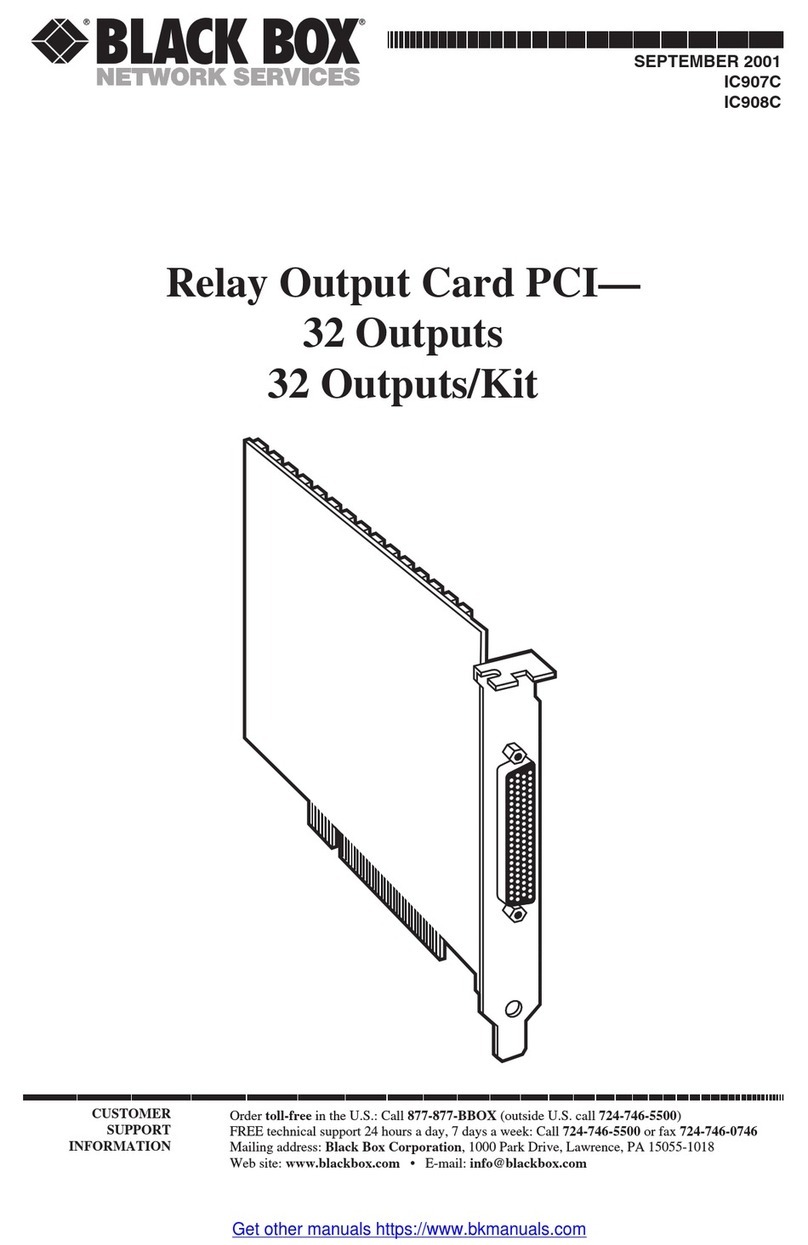
Black Box
Black Box IC907C User manual
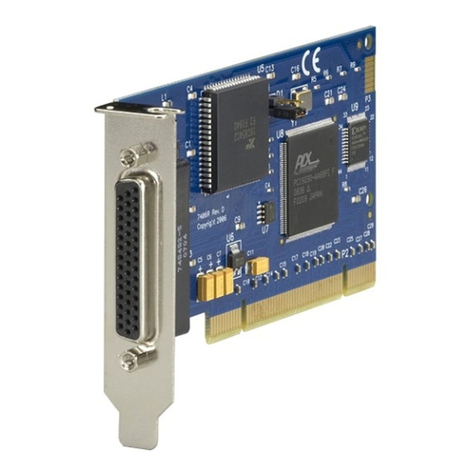
Black Box
Black Box IC132C User manual
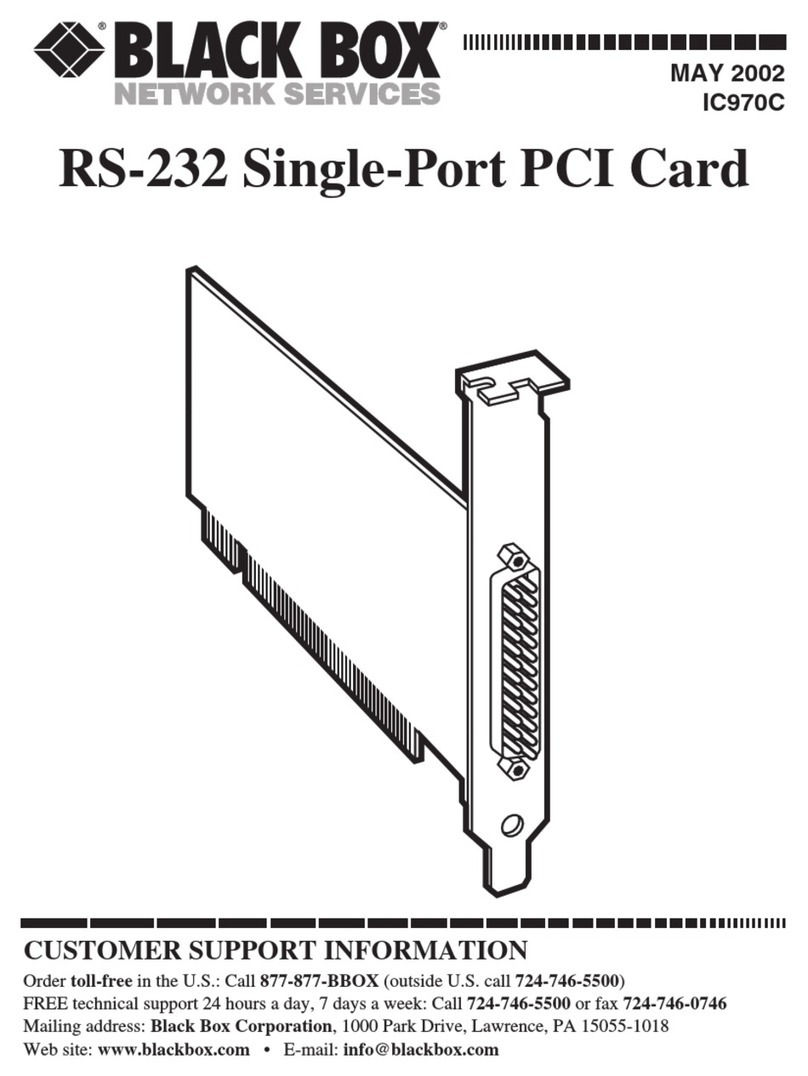
Black Box
Black Box IC970C User manual
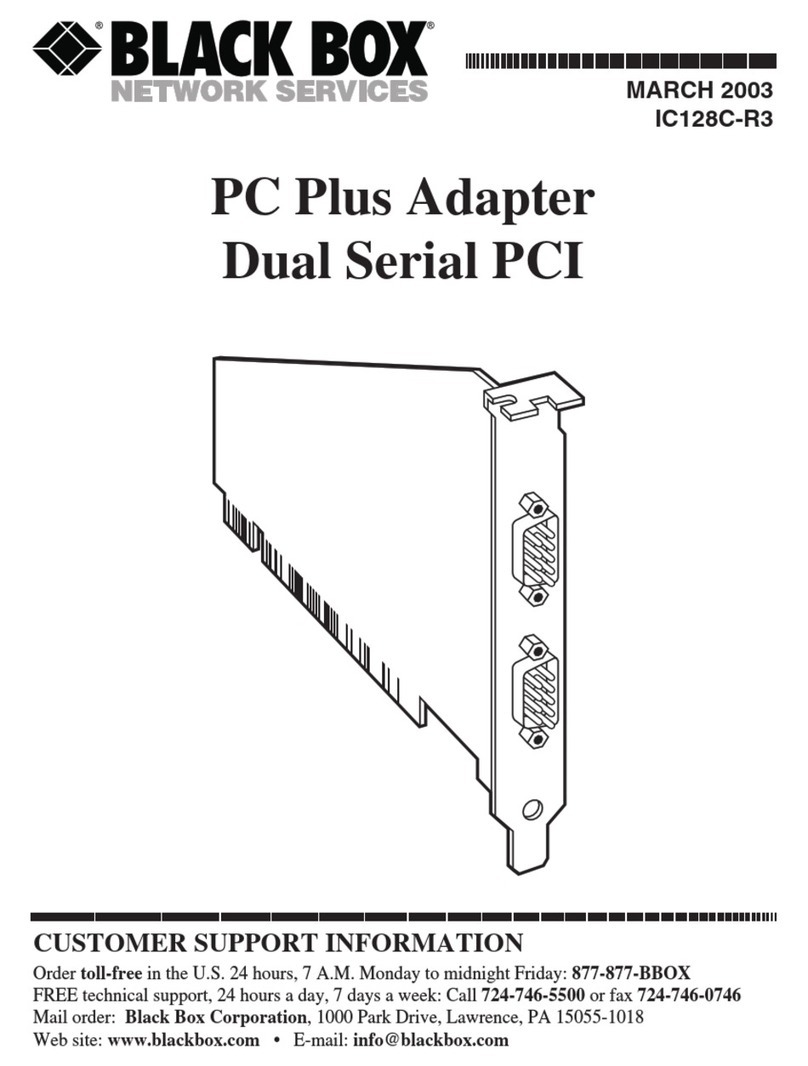
Black Box
Black Box IC128C-R3 User manual
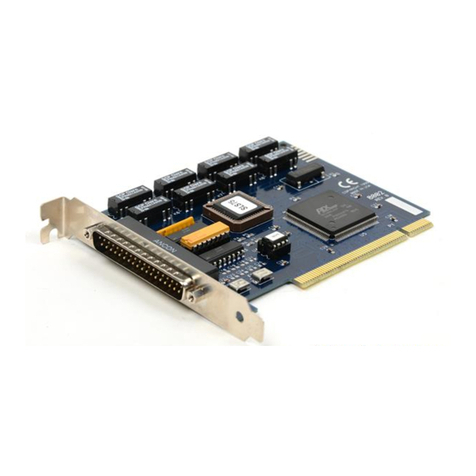
Black Box
Black Box IC904C User manual
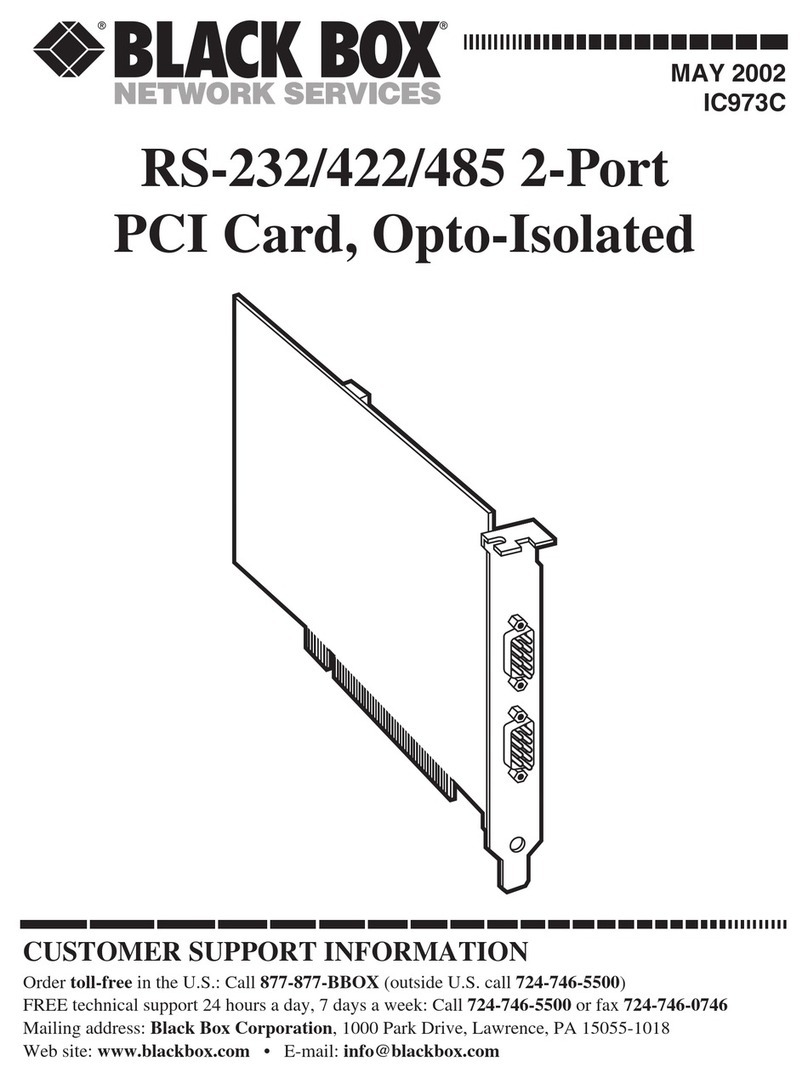
Black Box
Black Box USB Director RS-232 User manual

Black Box
Black Box USB Director RS-232 User manual
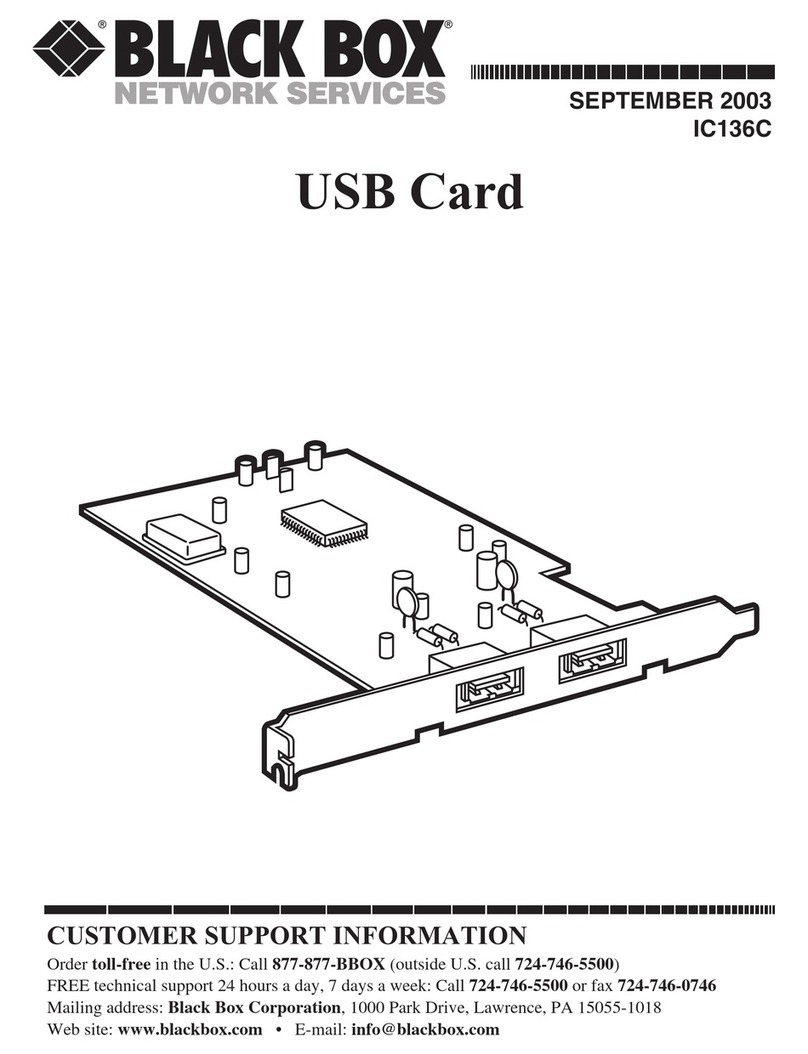
Black Box
Black Box IC136C User manual
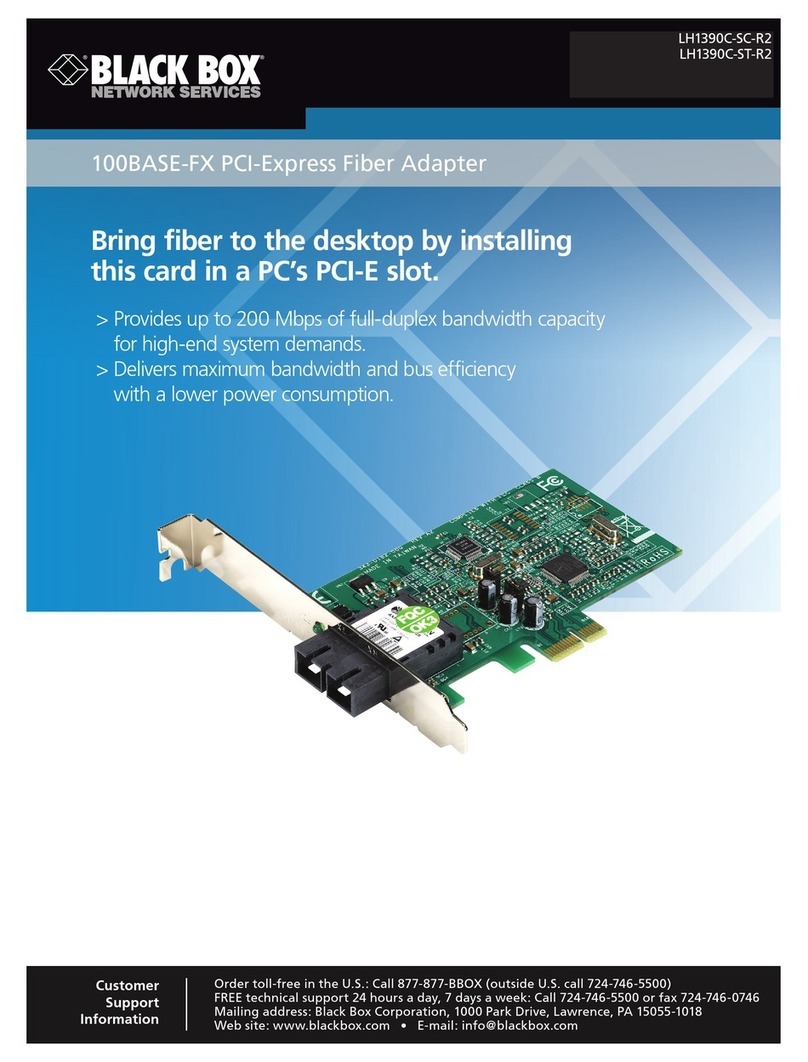
Black Box
Black Box LH1390C-SC-R2 User manual
